12th World of Malvasia: International Evaluation for Vinistra
April 24, 2021 - The best overture for Vinistra is the international evaluation of the World of Malvasia, which took place for the 12th time, in the Parentium Plava Laguna hotel in Poreč, which from year to year breaks records in terms of quality and number of samples. Thus, 435 samples of wine and spirits arrived for this year's evaluation, of which 220 samples were Malvasia.
As hrturizam.hr reports, a new name on the wine scene, Denis Bernobić from Markovac near Višnjan, won the championship title in the category of fresh Malvasia. Competing with three other top Malvasias, his wine took the win. This is also the biggest surprise at evaluating wine and spirits and the 12th World of Malvasia, which was traditionally held in mid-April at the Parentium Plava Laguna Hotel in Poreč.
"The lineage has always been the foundation of the existence of us Istrians. My family has been in winemaking for four generations, but the focus has been on top-quality wines for the last few years. The championship title is a great success, I must admit a surprise, but also recognition and encouragement to continue in the same direction", said Denis Bernobić.
Malvasia Collina from the 2016 winery Cattunar from Nova Vas near Brtonigla is the champion in the category of mature Malvasia; Teran Barbarossa, Vina Tomaz from Motovun, won the championship title in the fresh Teran category; while in the mature category, that title went to the wine of Santa Lucia from 2018. Kozlović Winery from Momjan.
In the category of mature refoška, the champion is Capo d’Istria from 2013, Slovenian Vinakoper, and five big gold medals were awarded to wines that won more than 92 points. These are the 2015 San Salvatore Muscat White Benvenuti wines from Caldir; Muscat yellow from 2019. Capo wine from Fernetić; Malvasia volcanica from 1956 by Spanish manufacturer El Grifo Canari; Merlot from 2017 Siljan wines from Krnica, and Aura biska extra from 2021 from the Buzet distillery Aura also won big gold.
"We are extremely pleased that we have managed to organize such a demanding competition in these unusual times. I am pleased with the top quality of the champion wines and the fact that as many as five wines crossed the threshold of 92 points and won great gold", said Nikola Benvenuti in front of Vinistra.
Another 139 gold and 16 silver medals were awarded, while other manufacturers received diplomas. This year, the right to the IQ label - Istrian quality was exercised by 24 winemakers for Malvasia and seven winemakers for Teran.
The IQ - Istrian quality label is primarily intended to label high-quality wines produced from Istrian and Teran Malvasia grapes and encourage the development of production of these indigenous wines, raising the level of their quality production technologies and promotion and sales on the domestic and world markets. The IQ mark enables the consumer to recognize those Istrian wines whose quality is higher than the quality prescribed by the law for quality wines with the geographical origin and higher than what the customer usually requires and expects.
This is a unique, active wine control system in Croatia where winemakers themselves gradually raise the scoring threshold for wines bearing the IQ - Istrian Quality label to standardize and increase product quality. The IQ label guarantees an active quality control system that takes place on four levels: in the vineyard (yield control), in the cellar (vinification control), chemical analysis, and organoleptic evaluation, and after the label is awarded, market control is performed.
This is precisely how the quality of the wine region is strategically raised and branded. It is important to emphasize that the Association of Winemakers and Winegrowers of Istria was founded in 1994. Therefore, it is a continuous process and strategic goal of raising Istrian wines and branding Istria as a wine region.
Great results and championship titles are the best announcement of the 27th Vinistra, which is being held in the open air for the first time this year, in the Peškera bay in Poreč. Although it was initially announced that the 27th in a row Vinistra will be held from 7 to 9 May in Poreč, due to the epidemiological situation throughout Croatia, the organizers announced that they are changing the date and place of the event.
The exact date is not yet known. For now, the focus is on June. The organizers of Vinistra are optimistic and do not give up on organizing this year's Vinistra.
To find out more about Croatian Wine, click HERE.
Highlights of the Week: 5 Top Events in Croatia from April 12-18, 2021
April 18, 2021 – Apart from the news about TCN's CEO Paul Bradbury being sued by the Croatian National Tourist Board, this week has been full of many other exciting yet inspiring news stories. Here are TCN's five biggest events in Croatia from April 12 to 18, 2021.
With the worsening epidemiological situation and tightening measures in four Croatian counties on Monday, the week didn't start very promising nor positive. However, a lot can happen in seven days, and we list five top news stories from Croatia.
Highlights of the week: Croatian National Tourist Board sues Paul Bradbury
Croatian media have been flooded this week with the news about the two lawsuits against TCN's CEO Paul Bradbury, submitted by the Croatian National Tourist Board because of Bradbury's criticisms of their work.

Source: Telegram.hr
Namely, CNTB filed two lawsuits against Bradbury, one for a Facebook joke he posted and the other for statements he said in an article on the Croatian portal Index. There was simply no stopping talking about these controversial lawsuits that appalled and disappointed the public this week. Read all the details about the first and second lawsuits in our articles.
Highlights of the week: Rimac Automobili presented a new incredible campus
On the list of people who promote Croatia in the best possible way, Mate Rimac takes one of the leading spots. His company Rimac Automobili never ceases to surprise with the novelties, such as the latest news about constructing the impressive new campus with numerous facilities.
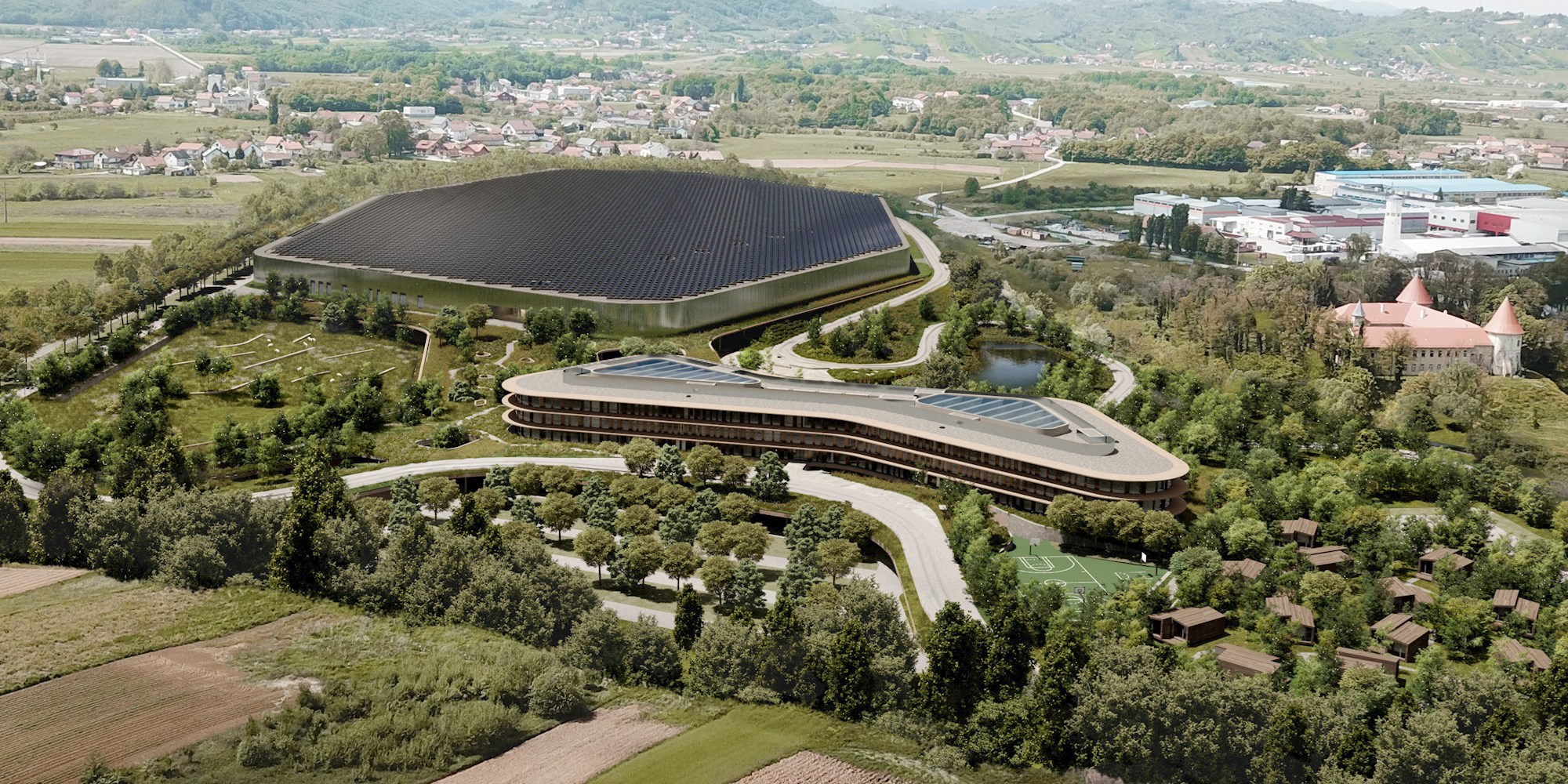
Source: Rimac Automobili
See the impressive video and photos of the forthcoming Rimac campus that stunned the whole of Croatia this week.
Highlights of the week: Many fantastic flight news for Croatia
Although all travel is currently questionable due to the epidemiological situation, hope is still restored by numerous information about flights to and from Croatia published this week.
Thus, for example, Israeli El Al and Arkia flights to Croatia continue, as well as Austrian flights, Polish LOT, Finnair, and Eurowings.
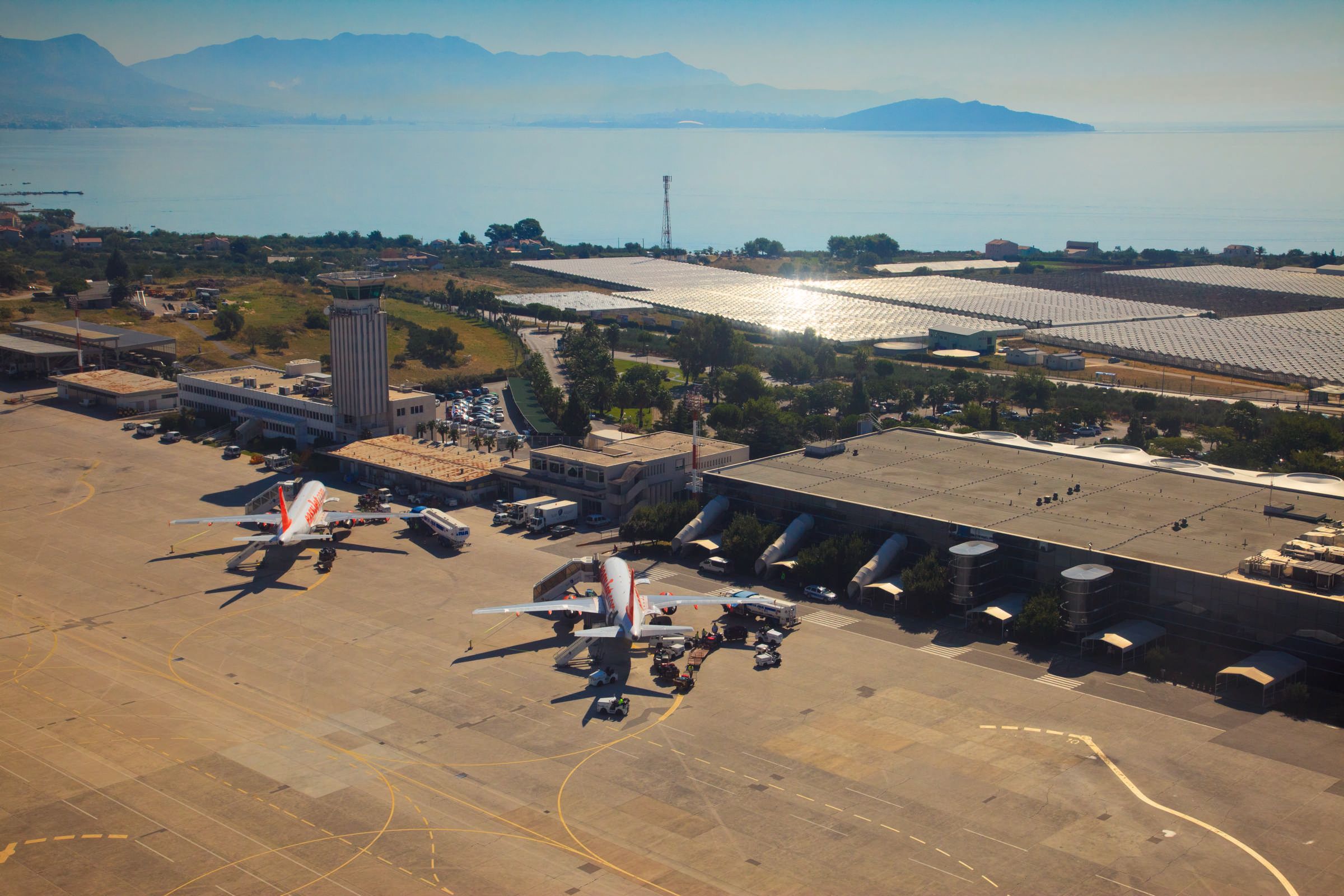
Split airport by Romulić and Stojčić
And even though Croatia will have to wait a bit longer for introducing direct flights from the USA, from this week, the travelers can get from Sarajevo to Chicago by Eastern Airlines.
Highlights of the week: Croatia women's handball national team won HEP Croatia Cup
Croatian athletes do not stop surprising us positively from week to week!
After defeating the current world champions, the Netherlands, the Croatia women's senior national team also defeated the former world champions Brazil and won the HEP Croatia Cup in Poreč.
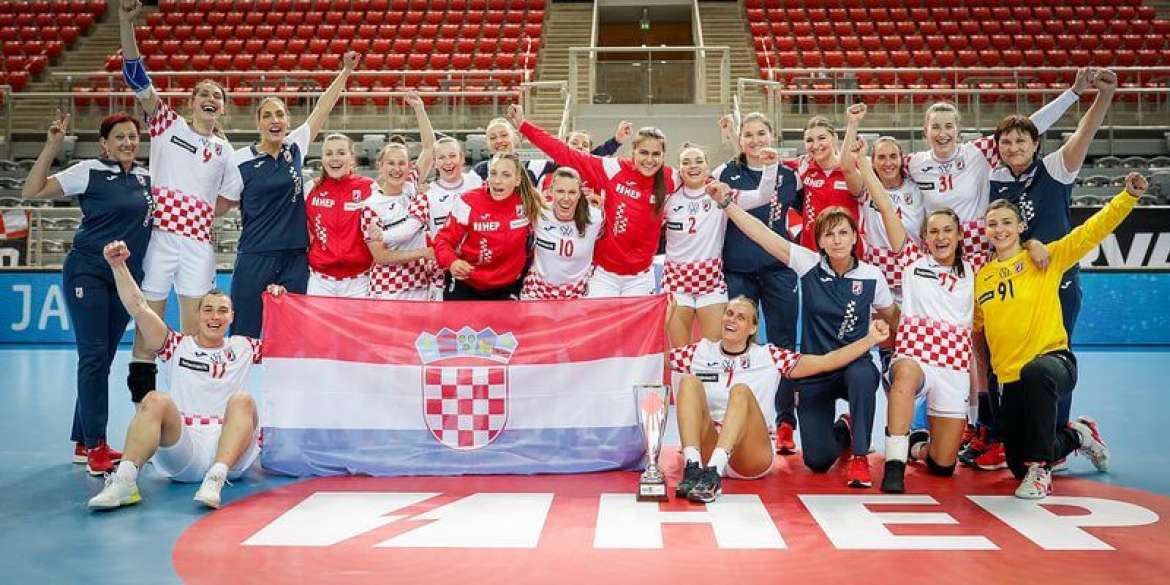
Source: Hrvatski rukometni savez
Highlights of the week: Klepetan returned to Malena again!
And to sweeten this week, the most famous Croatian love story got its happy follow-up. For the 19th consecutive year, the white stork Klepetan has returned from the south to the nest of his beloved Malena, continuing one of the most beautiful animal love stories in the world!
Spring may not have returned in the form we know, given that this week's temperatures in Croatia are more like autumn's, but it seems like the natural world is very much following its course.
To follow all news from Croatia, subscribe to our newsletter.
Croatia Women's Handball Win HEP Croatia Cup in Poreč!
April 17, 2021 - The Croatia women's handball team is the winner of the HEP Croatia Cup in Poreč!
After defeating the current world champions, the Netherlands, the Croatia women's senior national team also defeated the former world champions Brazil and became the winner of the HEP Croatia Cup. In a tough match with a lot of equal play, Croatia did better at the end of the second half and celebrated 24:21.
Croatia only made one change compared to the match against the Netherlands, and instead of Nataša Miočinović, the young Ema Guskić entered the game. Marijeta Vidak remained in the stands as in the first match. On the other hand, Brazil included Gabriela Moreschi in the team instead of their official first goalkeeper Barbara Arenhat. Croatia opened the match with Tea Pijević, Andrea Šimar, Nikolina Zadravec, Ana Debelić, Dora Krsnik, Valentina Blažević, and Ćamila Mičijević.
Croatia took the lead first, then Brazil went to +1. After 10 minutes, it was 3:3, and in the final five minutes, it was 8:10 for Brazil with goals by Anastacio and Amorim.
Milosavljević helped return Croatia's lead from the seven-meter throw. The battle continued in the second half. Brazil was powerful and physical, but Croatia matched them well. The defense worked, Pijević was solid in goal, and in the 49th minute, Mičijević scored for 18:16, Croatia's first +2 lead.
Milosavljević's made it +3. Croatia kept that advantage until a minute and a half before the end when Mičijević was excluded. Brazil scored from the penalty spot. Croatia lost the ball in the attack, but Vieira missed, and Krsnik solved all doubts in the last seconds with a goal for the final 24:21.
The most efficient players for Croatia were Dejana Milosavljević with seven goals and Ćamila Mičijević with six goals. Tea Pijević recorded 10 saves. Bruno de Paula was the best for Brazil with five goals.
Croatia: Bešen (0+1), Pijević (10); Zadravec 1, Plahinek, Krsnik 1, S. Posavec 1, Mičijević 6, Milosavljević 7 (4), D. Kalaus, Ježić 2, Japundža, Franušić, Šimara 2, Debelić 3, Guskić, Blažević 1. TRENERICA: Snježana Petika.
Brazil: Moreschi (5), Arruda (5); De Paula 5, Arujo 1, Amorim 3, Barbosa, Araujo 2, Cardoso 5(3), Vieira 2, Guarieiro, Bitolo, Anastacio 2, Matieli, Da Rocha, Costa 1, Ventura. IZBORNIK: Jorge Duenas.
To follow the latest sports news in Croatia, follow TCN's dedicated page.
To learn more about sport in Croatia, CLICK HERE.
HEP Croatia Cup: Croatia Women's Handball Tops World Champion Netherlands, Again!
April 15, 2021 - At the opening of the HEP Croatia Cup in Poreč, the Croatia women's handball team defeated the Netherlands 24:23, showing that their magic from the European Championships in Denmark is still there.
They delighted us at the European Championships in Denmark, told the most beautiful story, and won the bronze medal, proving that there is hope in Croatia women's handball as well. The 'Queens of Shock' again surprised the current world champion, the Netherlands, to open the never stronger HEP Croatia Cup in Poreč.
In the first match after the Euros, Croatia again met the Netherlands, a team they beat 27:25 in the preliminary group in Denmark. Both national teams came with different lineups, and the Netherlands were without a couple of players due to COVID-19. Croatia was led for the first time by coach Snježana Petika, the first assistant coach to Nenad Šoštarić, who is in quarantine.
Croatia opened the match with Pijević, Šimar, Zadravec, Debelić, Mićijević, Blažević and Krsnik.
Croatia took the 5:3 lead, followed by a 5:0 series by the Netherlands. Petika called a time-out at 5:8, and Croatia's turnaround followed. The defense was strengthened, the goals and counters were no longer missed. Wester defended well, but Pijević was even better. Dora Kalaus played an important role, and Croatia was up 13:10.
It was 20:15 for Croatia in the 46th minute, and just when everything seemed to be settled, the world champions did not give up so easily. In a dramatic ending, the Netherlands returned at 24:23 in the last minute, Rompen then defended the 7-meter throw of Blažević, but Croatia managed to defend, and in the end, celebrated the deserved victory.
Camila Mičijević was again Croatia's top scorer with seven goals. In addition to goalkeeper Pijević, Krsnik should also be praised, who scored five goals, while Zadravec, D. Kalaus, Ježić, Šimara, Debelić, and Blažević added two goals each.
Brazil and the Netherlands will play in Poreč from 6 pm on Thursday (Planet Sport), while Croatia and Brazil will close the HEP Croatia cup on Friday (8 pm, RTL2).
To follow the latest sports news in Croatia, follow TCN's dedicated page.
To learn more about sport in Croatia, CLICK HERE.
Porec Swans: Croatia As a Year-Round Residence for These Lovely Creatures
April 2, 2021 – This winter, Porec got two new discreet white tenants, a pair of swans, often seen in Peškera Bay. Due to the great interest, experts from the Porec Center for Invasive Species bring interesting facts about these wonderful, protected birds – Porec swans.
Written by: dr.sc. Barbara Sladonja, dr.sc. Danijela Poljuha, and mag.oecol. Mirela Uzelac.
Faithful couples
This pair of swans belong to the species of red-billed swans (lat. Cygnus olor). In English, they are called "mute swans" or silent swans because they are the quietest of all swan species.
The mute swan is one of the largest birds that can fly. They feed primarily on underwater vegetation, grass, algae, and the like and sometimes eat smaller fish and insects. You can feed them with pieces of bread or cereals such as wheat or corn. They catch food by diving into the water with the front of the body and the neck outstretched while the body's back protrudes into the air. They eat up to 3-4 kilograms of food a day!
They usually live in pairs their whole lives. Because of their faithful love and their necks that they can bend in the shape of a heart, they have become a symbol of love and fidelity, and an inspiration for many art and literature works.
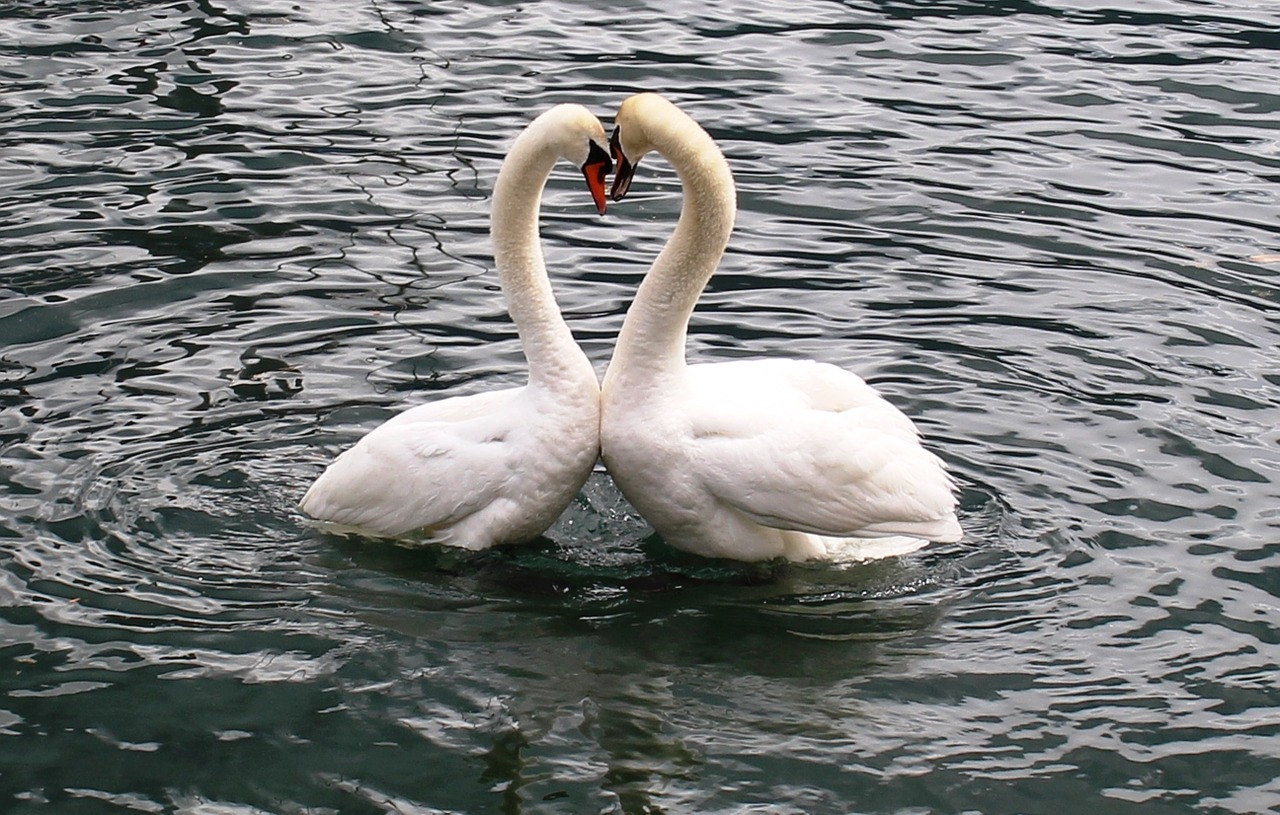
Pixabay
Where did they come from and why?
Swans are migratory birds, which means that they migrate from the nesting area (northern areas) to the wintering area (southern areas) and back every autumn. They fly in a flock. Sometimes, due to fatigue, the couples stand out and decide to spend the winter on the shores of warmer seas. They fly at speeds of up to 90 km/h and cross 1000 km to the nesting site.
Swans are spread in almost whole of Europe. Their number has increased in the last 50 years, and their area of residence and nesting has expanded. From just an occasional winter resort, Croatia and the Mediterranean have become their year-round residence.
Therefore, they spend the winter in Croatia more and more often. Since the early '90s, they have been nesting here. You can usually see them on inland lakes and in isolated places along the Adriatic coast. They inhabit areas of calm and slow freshwater, such as ponds, lakes, and swamps. You can also see them in brackish lagoons, salty bays, and on quiet shores. They are becoming more common in cities as well.
Our pair of swans chose Poreč because of the pleasant climate, beautiful city, and maybe the heart-shaped symbol on the Peškera Bay, which was a lure for our gorgeous tenants.
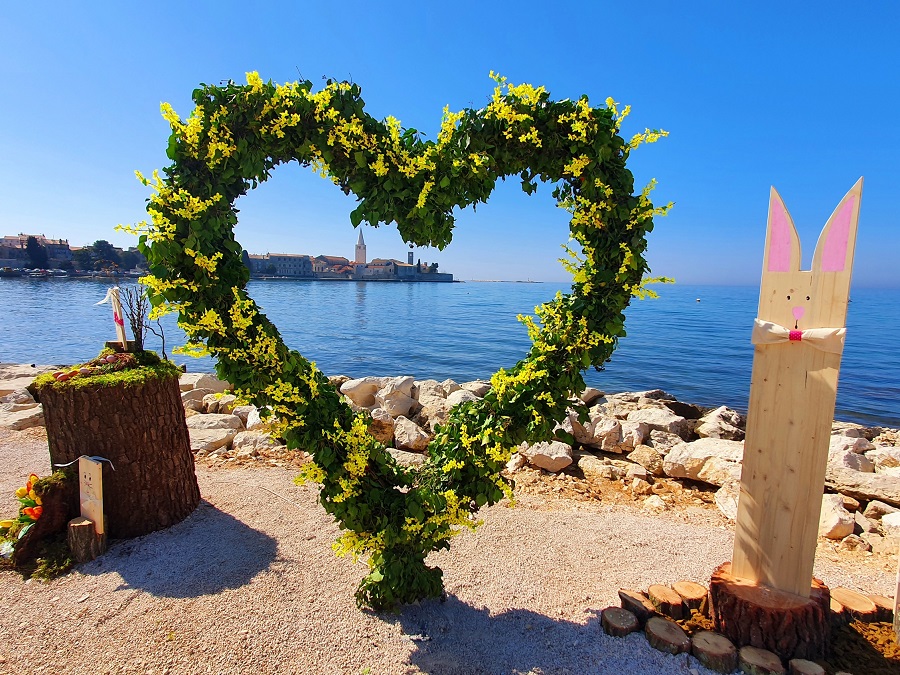
Easter decorations on the Peškera Bay in Poreč / The City of Poreč - Parenzo
Will they stay in Porec permanently?
Swans came to Poreč to spend the winter, and whether they will stay depends on whether they decide to nest here. If they choose to do so, the couple builds a nest together and keeps the birds. During that period, the male can be aggressive to protect the family. They nest from March to August near water, in shallow water, in aquatic habitats with reeds, cattail, or other aquatic vegetation, and sometimes in protected bays. There are not many such isolated habitats in Poreč, so they may decide to leave us, at least until next autumn.
And one more thing – although we are sure that we will all be hospitable and restrained towards them, let's not forget that the mute swan is a protected species in Croatia. Therefore, any intentional harassment, nest damage, egg destruction, injury, and similar actions can be punished.
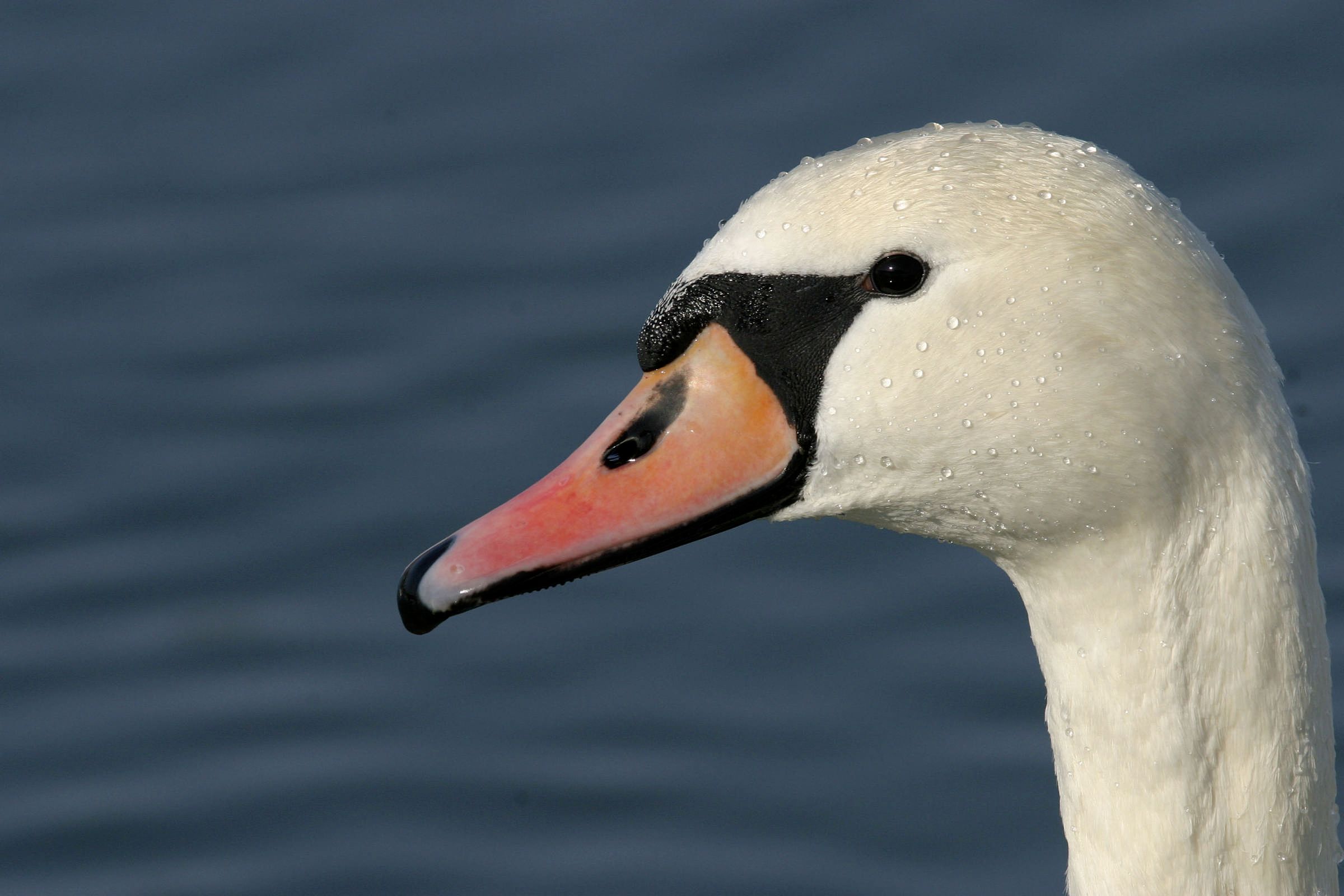
Romulić & Stojčić
Source: Poreč.hr
To read more about Poreč, check the Total Croatia article Poreč in a page.
Valamar Hotels Opening in Porec, Krk, Rabac, Rab, Makarska, and Dubrovnik Before Easter
March 29, 2021 - It'll be a busy week with Valamar hotels opening in Porec, Krk, Rabac, Rab, Makarska, and Dubrovnik before Easter!
Index.hr reports that just before Easter, the Valamar Riviera Hotel Group plans to open three hotels in Porec, two on Krk and one each in Rabac, Rab, Makarska, and Dubrovnik, and will also operate two camps, on Krk and Rab. For the spring holiday, Valamar expects domestic guests, just as they had during winter.
Valamar Riviera is the largest hotel group in Croatia, which manages 36 hotels and 15 camps in Istria (Porec, Rabac), Krk, Rab, and Hvar, and in Makarska and Dubrovnik, most of which open in May. Valamar also manages a hotel in Obertauern, Austria.
"In our northern destinations in the upcoming tourist season, we expect the most guests from Germany, Austria, Slovenia, and Poland, and in the southern locations, guests from Great Britain, France, Germany, and Croatia. During this winter, there were mostly domestic guests in the open facilities of Valamar, and we expect them during the Easter holidays, mostly in the arrangement of weekend stays," said Valamar.
Regarding tourist demand, they note that this year, similar to last year, higher demand is recorded by car destinations and camping resorts, with the expectation of intensified last-minute booking. Simultaneously, prices are said to be "dynamically determined through a 'revenue management' system according to Valamar's usual business practice."
"In all facilities and in 2021, the V Health & Safety program is applied following safety standards in Croatia and the recommendations of international health organizations, which in addition to high health, safety, and environmental standards, guarantees the improvement of cleaning protocols. Guests are provided with 24-hour support in case they need health care," said Valamar.
Valamar has also developed a package of measures through which it organizes all necessary health services for guests during their holidays, which includes the organization of antigen and PCR testing within the accommodation facility, as well as covering the costs of extended stay for people with COVID-19 and everyone included in their reservation.
Without giving exact figures, they point out that for this season, they are opening a "significant number of seasonal jobs," for which they offer a minimum net income of HRK 5,000 for the monthly fund of hours, accommodation, hot meals, and other benefits.
By the way, Valamar reached 7,000 employees in the record 2019 in the peak summer season, while according to the data from the business report for 2020, there were about 4,000 in the summer of 2020.
At the beginning of April 2020, Valamar launched the "Pause, Restart" program to preserve all jobs, which was extended until 31 March 2022 with the support of social partners. Under this program, all Valamar employees sent on standby without the obligation to work were provided with a salary compensation in the amount of 60 percent, but not less than 4,250 net kuna, with the support of the government's to preserve jobs in the affected industries.
Among the news for this tourist season is the launch of the lifestyle brand [Places] following the trend in the international hotel industry for lifestyle hotels that are aimed at creating a unique experience with authentic service, which emphasizes the most valuable in the destination and contributes to nature conservation and environmental sustainability.
Such hotels attract modern travelers, primarily "millennials" and young professionals. The first hotel under this brand is Hvar PlacesHotel in Stari Grad on the island (former hotel Lavanda from Helios Faros, which is in partnership with a pension fund PBZ Croatia osiguranje taken over in 2019).
They are investing around 53 million kuna in the hotel's renovation, and according to current plans, it will open in mid-May.
This is where guests from the markets of Great Britain, the USA, Germany, and Austria, but also Croatia, are most expected.
Hvar as a destination is "positioned in the market segments of younger, relaxed, and at the same time, experientially and environmentally aware people," said Valamar Riviera Vice President for Sales and Marketing Davor Brenko.
"We have high expectations from the new brand in the future, and in the next period, we plan to open several more such hotels," Brenko announced.
For the latest travel updates and COVID-19 news from Croatia, CLICK HERE.
Poreč Strengthens Agriculture with Exciting New Projects
March 24, 2021 - Poreč strengthens agriculture with exciting new projects implemented by the City.
Last Friday the city of Poreč signed contracts for assigning funds to the agricultural civil societies to help their projects and programs. The continuation of the tradition established in the last two years, Poreč city gave 150.000 kuna to associations Bio Istra and Agro Poreč through a public contest, both for their day-to-day work in agriculture and for the project "Eko! impjantamo ružmarin" (Eco! let's plant rosemary) which includes going to schools and giving pupils unprocessed rosemary to plant in the school. The project is at full speed and even the coronavirus pandemic didn't stop them, as the first phase of the project was done via Zoom. In the early stages of the project, the goal is to establish cooperation between the only two high schools in Poreč: Mate Balot High School and Anton Štifanić Tourist School.
"We started with the first workshop in preparing rosemary seedlings with the agrotechnical pupils at Mate Balot and we will use it to decorate the garden of Anton Štifanić Tourist School," said Vlasta Radoičić, president of Bio Istra. Her association exists for the past 23 years and is working on the county level, determined to activate as many people as possible to boost family agricultural businesses.
"Poreč was the cornerstone of eco-agriculture and it needs to remain that today and become a modern teacher of the area", concluded Radojčić.
Poreč is one of the strongholds of Croatian tourism in Istria, but it's also a truly agricultural city. Loris Peršurić, mayor of Poreč not only knows it but strongly supports it.
"We have a 145-year-old institute for agriculture and tourism as well as a 138-year-old agriculture school, the only one in Istria, which means a lot for our city", said Peršurić. He adds that is precisely why he tries to support and help projects related to agriculture which includes co-financing the Centre for invasive species in common projects and as mayor, hopes to valorize a wine cellar that dates from the Austro-Hungarian Monarchy rule and is known today as enoteca (wine library) in the community. "Poreč is the headquarters of famous winemakers and olive oil makers and our agricultural story continues to grow and develop", concludes Peršić.
The city also finances the project "Apply for Agriculture School - Produce Food and Take Care of the Environment" which resulted in a 50% increase in pupils educating in the school and there are opportunities for pupils to continue education in the field in Poreč too.
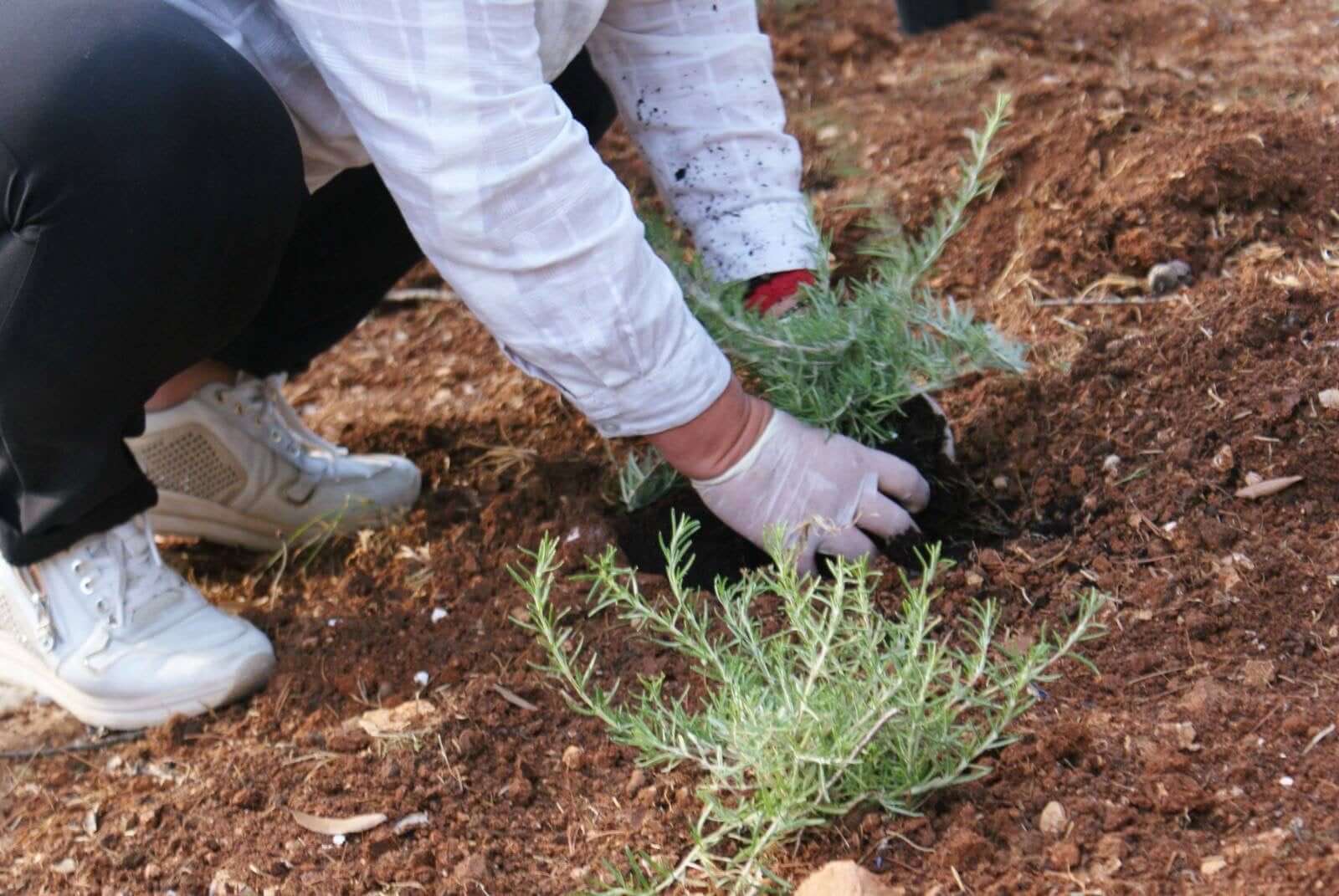
seedling planting © Udruga Bio Istra
Local olive treasure
Poreč is also proud of its local olive species Porečka Rosulja, which was first described by a famous local scientist Carlo Hugues 120 years ago. The olive wasn't researched much after that, but today, scientists from the Agriculture and Tourism Institute are out on the field to pursue the described treasure of the Poreč olive scene. Agro Poreč association secretary Zdenko Barac whose organization is dedicated to promoting local agriculture and seedlings distribution is included in this research. He is thankful that the city recognized the importance of Porečka Rosulja and its investment in the "mother field" in Poreč where new seedlings will be prepared for further distribution and for another olive plantation in St. Martin Bay, which will have both educational purposes and will be a nice architectural touch to the landscape of the area. No to mention, a nice dedication to Hugues which first described the species.
"The number of seedlings is growing. This is the third year of the project where we have 530 seedlings and we started with 170 in 2019", says Barac. The plan is to prepare the best seeding material and apply them to the Croatian Center for Agriculture, Food, and Rural Affairs.
"There are very few cases in the world where a species is named after city so we can boast about that", concluded Barac.
For more about agriculture in Croatia follow TCN's dedicated page.
Qatar National Parachute Team Preparing in Porec for World Cup in Russia
March 17, 2021 – Numerous football and handball teams, as well as many other athletes, have been traditionally preparing for sports competitions in western Istrian towns. That Istria is a perfect destination for sports preparations is recently even evidenced by the Qatar national parachute team preparing in Porec for the World Cup in Russia.
In recent days, many people from Poreč have been able to notice the flight of purple and white parachutes in the sky above their city. Namely, the Qatar national parachute team is preparing in Poreč for the World Cup in Russia under the leadership of Slovenian Uroš Ban, multiple world champion in parachuting.
As Ban mentioned, the national team decided to do the preparations in Istria because there is the necessary infrastructure such as a sports airport, parachute jumping equipment, and accommodation infrastructure. That decision was favorable for a relatively quick resolution of the required paperwork, too, due to the difficulty of traveling to other destinations during COVID.

Source: The City of Poreč - Parenzo
With a total of 14 members, the Qatar national parachute team will stay in Istria for a month and will be preparing for the classic parachute disciplines. Everyone's goal is the same – to jump from a height of 1000 m to a point with a diameter of 2 cm. Every missed centimeter is measured electronically and added up as a penalty point. Each jumper does a dozen jumps a day, and each jump is affected by the weather, especially the wind.
Apart from them, the Croatian parachuting team's coach, Goran Ratkajec, has been staying in Poreč for most of the year. Besides the parachute club, he also makes smaller sports planes in the Žatika zone in Poreč.
The World Parachuting Championship, which was supposed to be held last year in Russia, has been postponed due to the coronavirus pandemic, so a decision is pending on whether the World or European Championships will be held first this year. Either way, the Istrian sky will be dotted with paratroopers.
Source: The City of Poreč - Parenzo
To read more about sport in Croatia, follow TCN's dedicated page.
People Also Ask Google: How Far is Porec from Other Parts of Croatia?
March 2, 2021 – You've found yourself in Croatia, you've heard about Porec being an exciting town in Istria, and now you want to seize the opportunity to visit it? In our People Also Ask Google series, we explain how far is Porec from other parts of Croatia.
Although beautiful in all areas, Croatia is a country with an extremely unusual shape, making it difficult to travel from one part to another (for example, from Osijek to Dubrovnik). The long and very indented coast on the Adriatic Sea hides some of the most beautiful seascapes. Due to its specific position and numerous bays and islands, it is impossible to explore it in one fell swoop.
The largest peninsula in Croatia – Istria – is located in the north of the Croatian Adriatic coast and hides many natural and cultural sights in the west part of Croatia, where also lays Croatia's westernmost point – Savudrija. If in Croatia, it would be a shame if one does not take the opportunity and visit Istria. Cities on the west coast of Istria, such as Rovinj, Poreč, and Pula, have been attracting tourists' attention for years because of their proximity and excellent connections with Central Europe and its irresistible cultural heritage that makes them interesting destinations worth exploring.
We recently described whether Porec is worth visiting, and in this article, we will try to explain how far Porec is from other parts of Croatia and how to reach this one of the many Istrian gems easily.
However, if you are interested in how to get to Istria from Italy or Slovenia by car, bus, train, plane, or ferry, you can find all the information in the TCN's special guide.
How far is Porec from the airport?
Pula Airport – If coming by plane to Croatia, Pula Airport is the closest to Poreč. The distance between Pula Airport and Poreč is about 58 kilometers, of which 42 kilometers is the Istrian highway (i.e., the Istrian Y). The bus drive from Pula Airport to Poreč takes an hour, while the car ride takes 45 minutes. However, you can also take the local road through Istria. Still, even though it is a slightly shorter distance (52 kilometers), your journey will take at least 15 minutes longer in ideal conditions. Before you choose a route, consider that local roads in Istria can be very crowded during the summer season.
There are shuttle bus lines from Pula Airport to the main Pula bus station, 30 minutes after the landing of the aircraft, from where you can take a bus to Poreč (as well as to other parts of Istria). The shuttlebus drive to Pula takes 10-15 minutes, and the ticket costs 30 kunas. You can check the Pula Airport shuttlebus schedule for 2021, as well as other shuttle bus services from Pula Airport.
From the main Pula bus station, you can easily take the bus to Poreč with services provided by Arriva, Flixbus, and others. The bus connection between Pula and Poreč is excellent, with many bus lines throughout the year and day, especially during the summer season.
If you decide to take a car ride from Pula Airport to Poreč, several rent-a-car businesses offer services at Pula Airport.
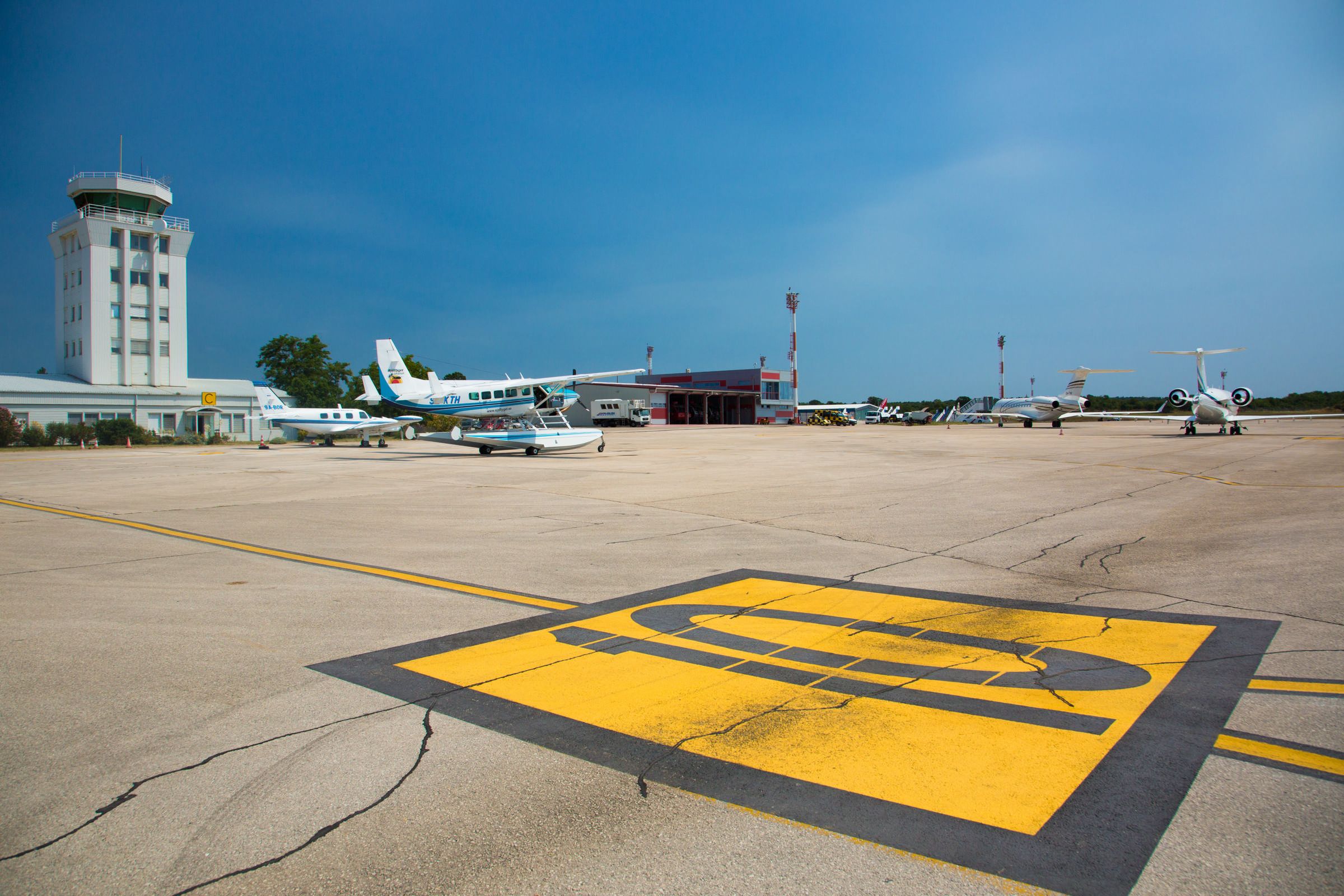
Pula Airport / Romulić and Stojčić
If you choose to take the local road to Poreč, you should follow the local D21 road, as seen on the photo below, and the journey will take about an hour.
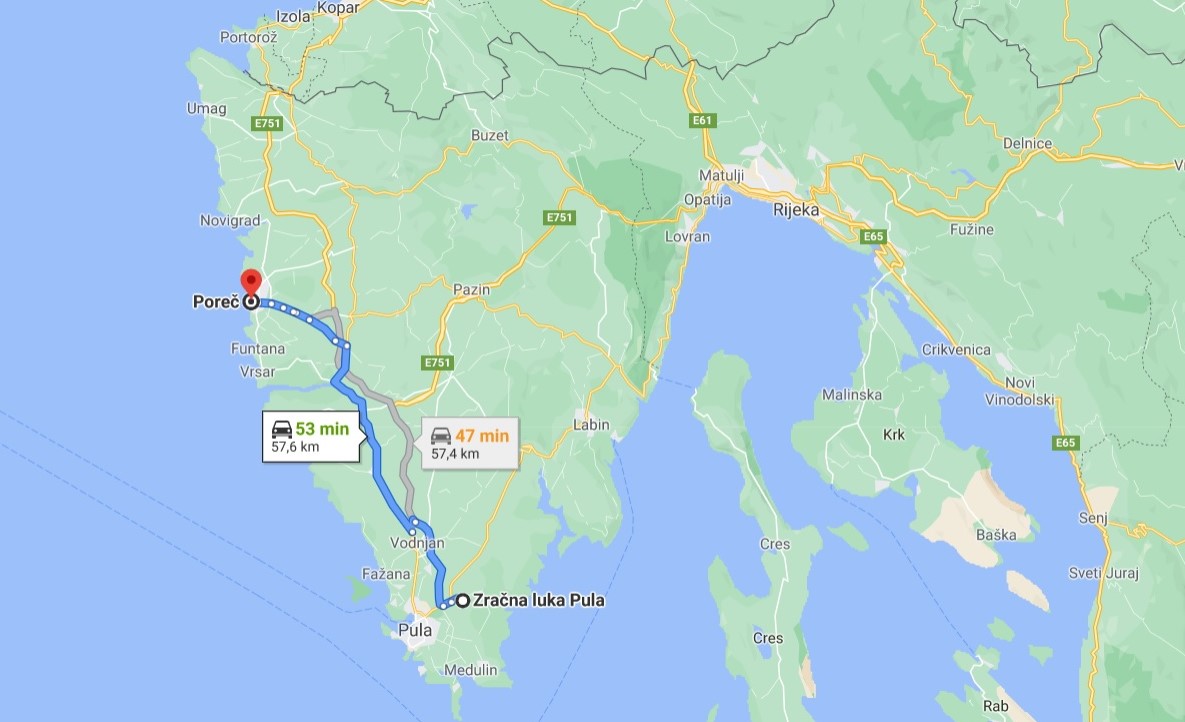
However, if you're taking the highway, you enter the E751 highway (A9 in Croatian) Istrian Y highway, at the Pula junction, and then get off at the Baderna junction. Note: A toll is charged on this route and costs 27 kunas for the first vehicle category. (Check all prices on Istrian Y here.) From Baderna, Poreč is only 17 minutes away by the local road. This route is showed on the photo below.
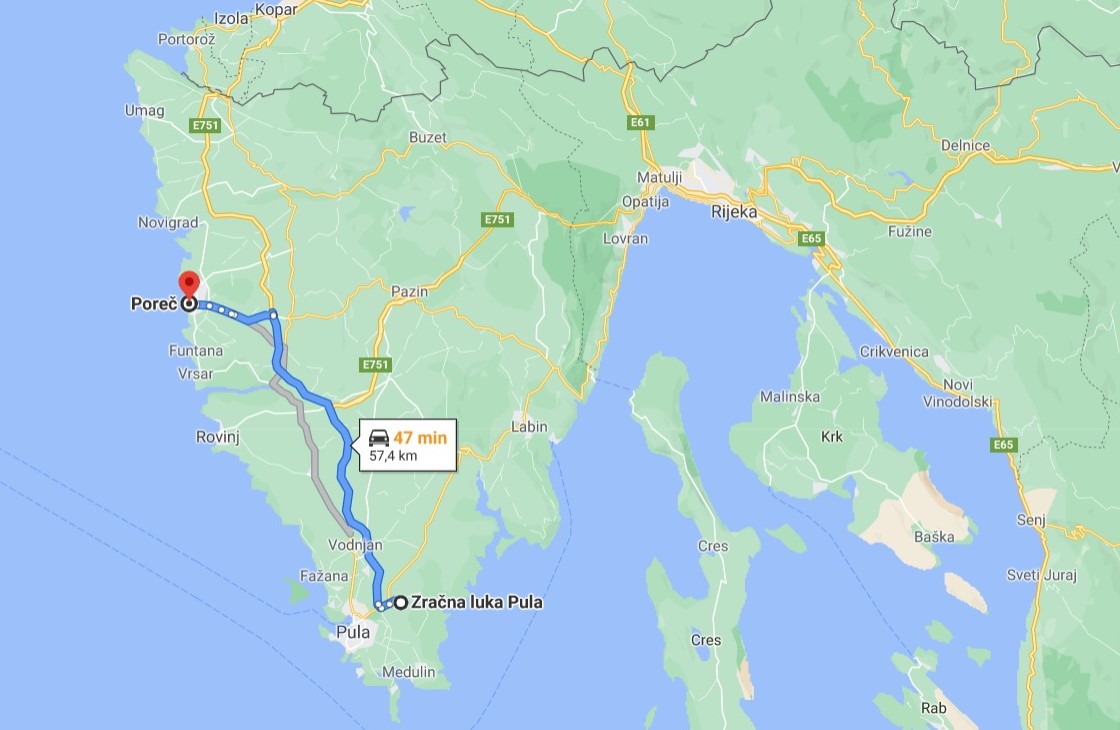
Check more cheap and quick ways to get from Pula Airport to Poreč here.
Rijeka Airport – The second closest Croatian airport to Poreč is Rijeka Airport, situated on the island of Krk, which is connected with the Croatian land by bridge. It is located about 30 kilometers from the center of Rijeka. Just like at the Pula Airport, the Rijeka Airport also offers shuttle bus services to the Rijeka city center, shortly after arrival of airplanes. However, during winter months, there's no regular shuttle service, but only service on demand from/to Rijeka and Omišalj on Krk. From Rijeka, you can take a bus to Poreč, and you can find more details about that route later in the article.
If you are traveling from Rijeka Airport to Poreč by car, you can rent a car at the Rijeka Airport, from where you'll get to Poreč in an hour and 45 minutes. The car route from Rijeka Airport to Poreč is about 115 kilometers, of which 75 kilometers is the highway (Istrian Y), and this is shown on the photo below. Find more info about Poreč to Rijeka by car later in the article.
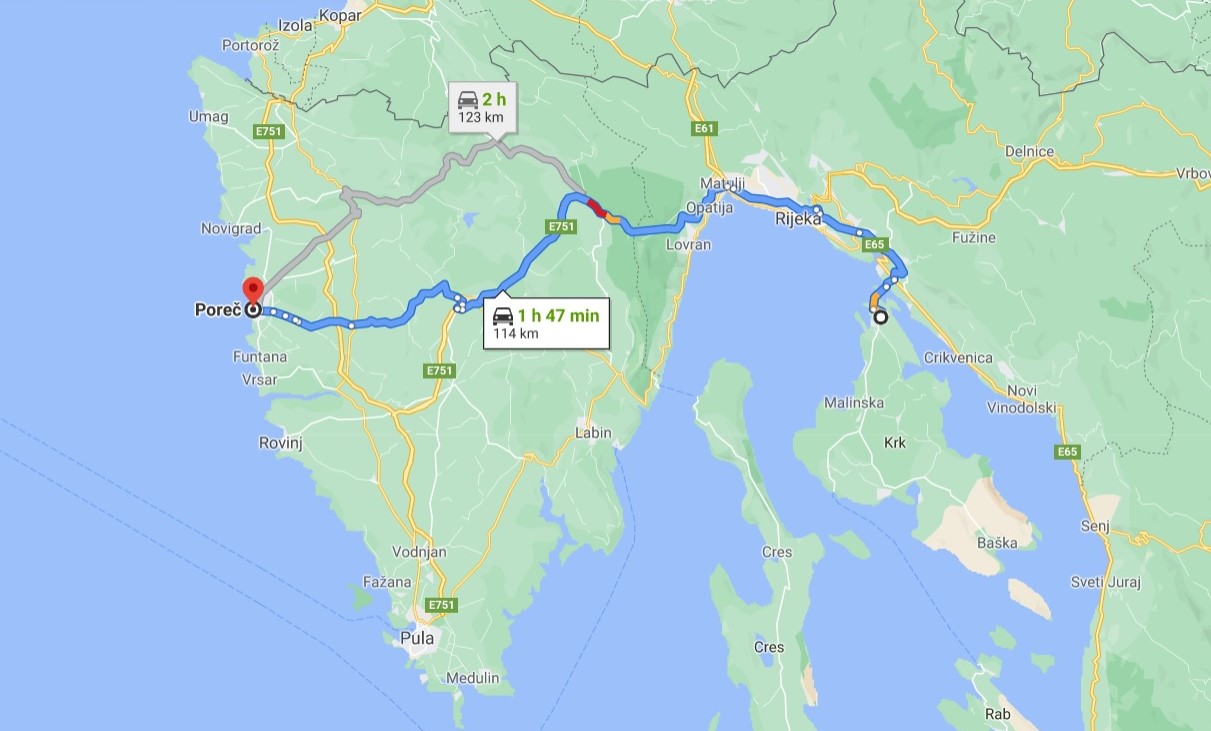
Check more cheap and quick ways to get from Rijeka Airport to Poreč here.
Other nearer airports to Poreč are Zagreb Airport, Ljubljana Airport, Trieste Airport, Treviso Airport and Venice Airport.
How far is Porec from Rijeka?
Poreč is 102 kilometers from Rijeka, and it takes an hour and 25 minutes of driving along the Istrian Y highway and local road by car. Of course, the traffic conditions should be taken into account, because during the season, the traffic can be increased which prolongs the time of traveling.
To go from Rijeka to Poreč by car, you can take the Istrian Y highway from Matulji near Rijeka and exit it in Rogovići near Pazin, from where you must continue to Poreč along the local road. Note: A toll is charged on the route from Rijeka to Pazin and costs 37 kunas for the first vehicle category. However, if you do not fancy paying a highway toll, and you'd like to stop at the Učka National Park along the way, you can take a local road D48 or D44 local road bypassing the Istrian towns of Buzet and Motovun. If you want to go along the eastern Istrian coast, you can take the local road number D66 to get from Rijeka to Poreč.
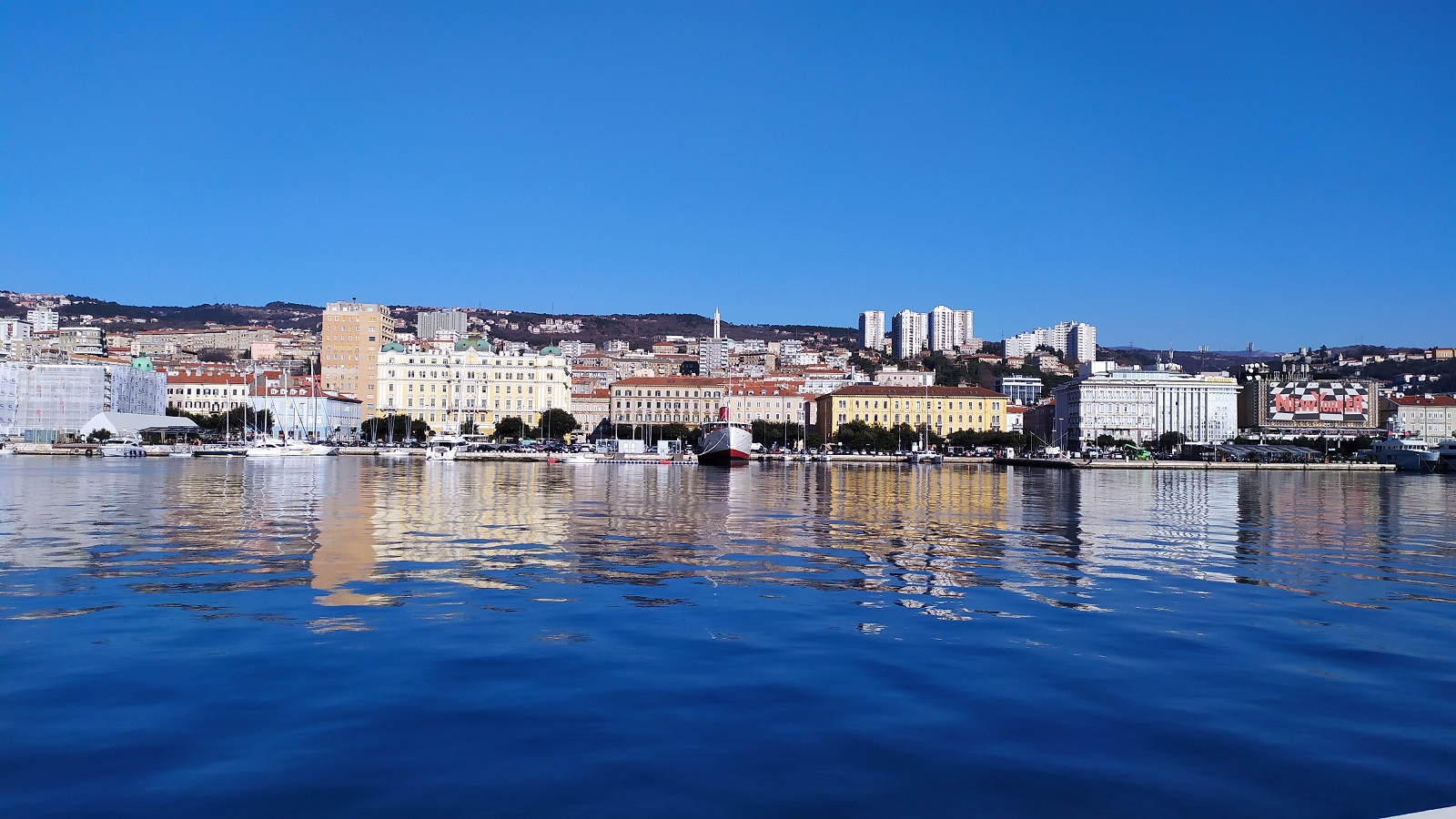
Rijeka / Donatella Pauković
Suppose you decide to take a bus from Rijeka to Poreč. In that case, there are several daily bus lines provided by Arriva, Flixbus, and other Croatian bus operators throughout the year and day. During the summer tourist season, the bus lines from Rijeka to Poreč are more frequent. It takes about an hour and a half from Rijeka to Poreč by bus, depending on the traffic conditions.
How far is Porec from Rovinj?
Poreč is 42 kilometers away from Rovinj, and you can quickly get there by bus in 45 minutes, and even faster by car. During the high summer season, there can be more traffic, so traveling time can vary. Since these two Istrian towns are so close, there are also boat lines connecting them.
Ferry from Rovinj to Poreč served by TriesteLines runs twice per week in the high summer season but does not operate outside the season. The journey takes 30 minutes and is only a foot-passenger ferry. Neither pets nor bikes are permitted onboard. Due to the coronavirus pandemic, there are likely to be many alternations and cancellations of the ferry schedules, so you will have to double-check all information. The TriesteLines operates daytime connections exclusively during summer, from Trieste to and between the port of Piran in Slovenia and the ports of Poreč, Rovinj, and Pula in Croatia.
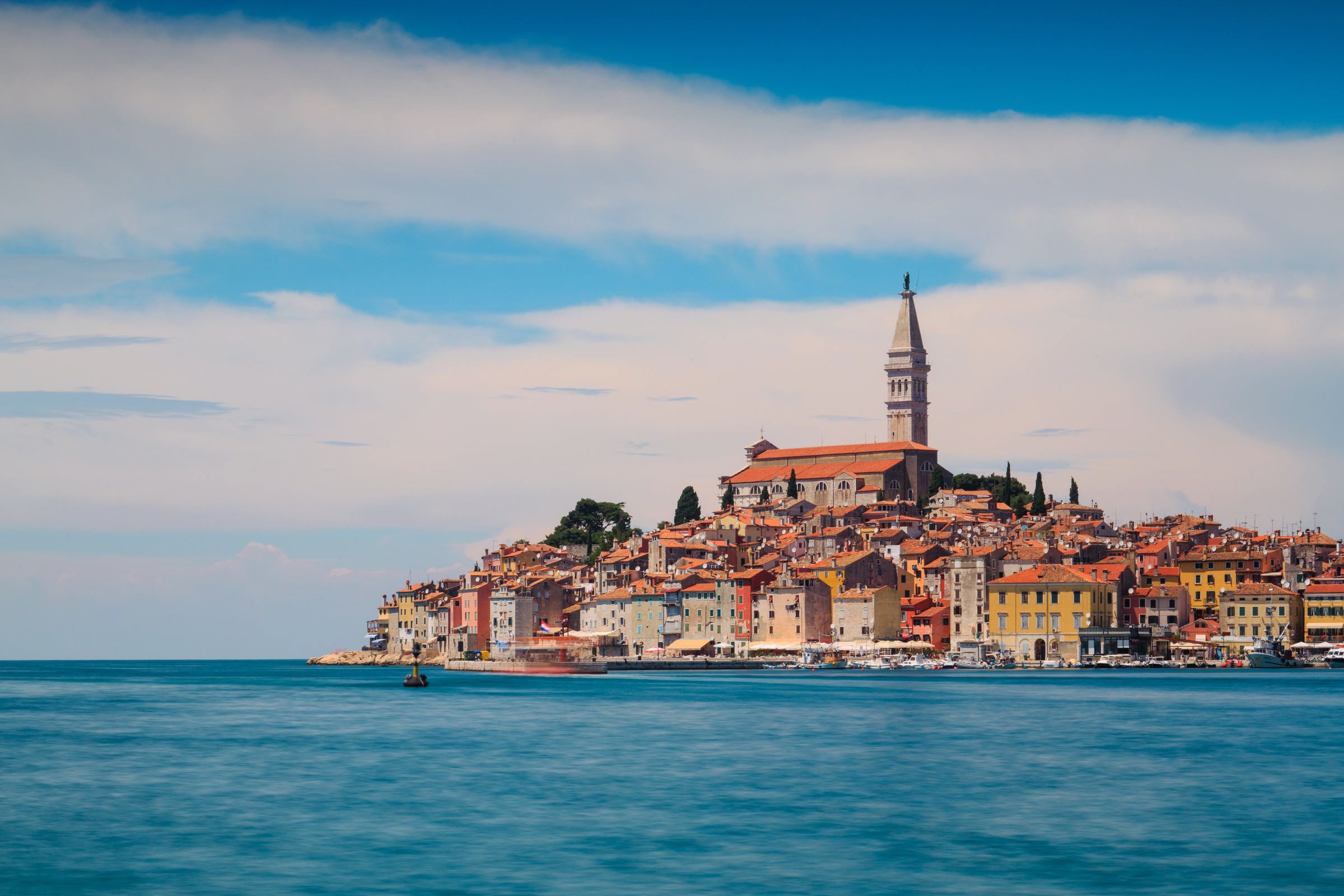
Rovinj / Romulić and Stojčić
If visiting only one town, you can easily book a one-day trip to another city. Poreč and Rovinj are separated by the Lim Bay (Lim Fjord), created as a rias of the river Pazinčica which in the past flowed into the Adriatic Sea, which today sinks in the Pazin Cave near Pazin. Hence, the road is enjoyable whether you ride a boat or car.
Several bus lines are running between Rovinj and Poreč every day, and during the summer season, there are even more of them. Bus lines from Rovinj to Poreč and in the opposite direction can be found here. You can also take the taxi from Rovinj to Poreč or find other transfer options.
How far is Porec from Dubrovnik?
Considering the fact that Dubrovnik, due to its separation and distance in the southernmost part of Croatia, is one of the hardest cities to reach in Croatia, it is quite far away from other parts of Croatia outside Dalmatia, including from Poreč. Since Poreč is 691 kilometers away from Dubrovnik, there are no direct bus lines between the two cities, but the alternative travel option would be through Rijeka. There are several bus lines operating from Dubrovnik to Rijeka, and Rijeka and Poreč are very well connected with bus lines, as explained earlier in the article.
A few bus lines from Dubrovnik to Rijeka operate throughout the year, while during the summer season, there are even more of them. The journey takes about 12 hours.
If you decide to take a car ride from Dubrovnik to Poreč, it will take about 7 hours and 50 minutes of traveling. For more details about crossing the Croatian-Bosnian border near the Bosnian town of Neum, check our dedicated article. From Dubrovnik, you can drive along the Croatian coast, i.e., the Jadranska Magistrala (D8 state road), and connect to the E71/E65 highway (A1 in Croatian) all the way to the junction Žuta Lokva in Lika (and pay a toll). From there, you can again take a local road and Jadranska Magistrala to Rijeka, where you can connect to the Istrian Y highway (as explained earlier in the article).
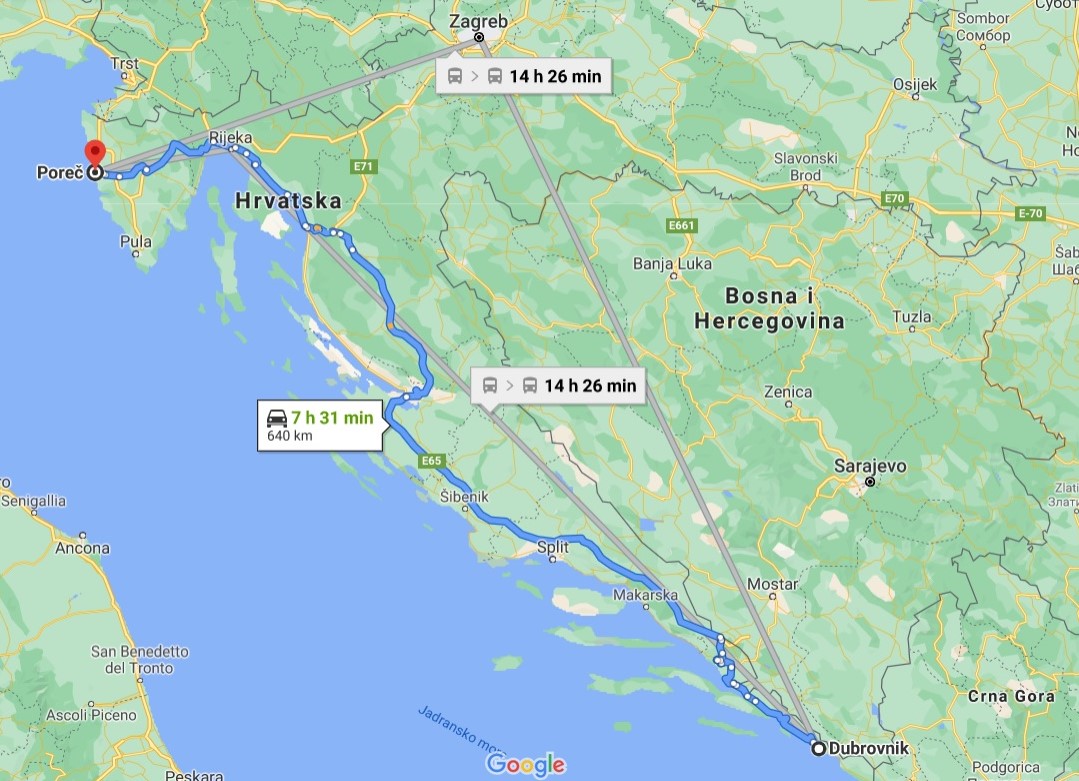
There are no ferry lines between Dubrovnik and Poreč either, nor between Dubrovnik and Rijeka.
How far is Porec from Split?
The distance between Split and Poreč is 451 kilometers, and just like with Dubrovnik, there are no bus lines connecting these two Croatian cities. Also, Poreč can be reached from Split by bus lines through Rijeka, as well as by car and highway.
How far is Porec from Zagreb?
Poreč is 250 kilometers away from Zagreb, and you can quickly get there by numerous bus lines throughout the year, as well as by a personal vehicle. If coming from the continental Croatia, Istria and Kvarner are the closest seaside destinations and easiest to reach.
How far is Porec from Osijek?
As with Zagreb, Poreč is also well connected with Osijek by bus lines operating throughout the year. Poreč is 530 kilometers away from Osijek, and it takes five and a half hours to get there by car. Some bus lines going from continental Croatia to Poreč stop in other smaller Croatian towns, such as Novska, for example, providing connected lines to Poreč. Check all bus lines to Poreč with Flixbus, Arriva, and other Croatian bus lines.
If you'd like to know the exact distances between cities in Croatia, you can check them all at one place (in Croatian).
To follow the People Also Ask Google about Croatia series, click here.
Porec Area Ready for Firefighting Season, Gets Five New Vehicles
February 27, 2021 – With five new vehicles, the Porec area is ready for the firefighting season, and is implementing the strategic EU project STREAM of climate change adaptation.
Under the chairmanship of Chief of Staff Denis Matošević, the City of Poreč-Parenzo and the Civil Protection Headquarters of Poreč held a meeting for preparing the fire season in the Porec area. Poreč Mayor Loris Peršurić also greeted those present and participated in the working part of the meeting.
As the regional fire commander too, Denis Matošević informed everyone present about last year's season, together with the Head of the Protection and Rescue Service of the Istria County Fire Brigade, Denis Stipanov. They adopted the work plan, financial plan, and operational implementation plan for the fire season.
They also discussed sites and areas for establishing appropriate command posts for fire fighting coordination. They also agreed that the Headquarters will be involved in cases when it is necessary to declare a major accident or catastrophe.
As Mayor Matošević mentioned, Poreč is ready for the fire-fighting season, and this year, they expect the delivery of as many as five new vehicles. With one larger forest extinguishing vehicle coming from the state budget, four new vehicles are under construction and their delivery is expected throughout the year. Additionally, in cooperation with the City of Poreč-Parenzo, they are implementing the strategic EU project STREAM of climate change adaptation.
"For us, this is an important and significant project that will provide us with valuable equipment worth 700,000 kunas. This will enable us to be one of the first fire brigades in Croatia that will be equipped to act in flood crisis situations," said Matošević.
At the end of the meeting, they concluded that the preparations for the fire season 2021 in the Poreč were made in a timely manner.
For the latest travel info, bookmark our main travel info article, which is updated daily.
Read the Croatian Travel Update in your language - now available in 24 languages.


